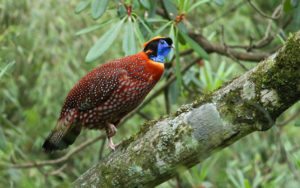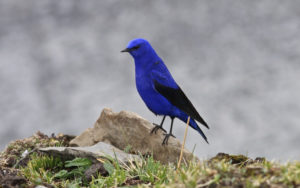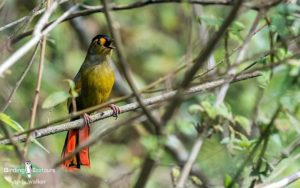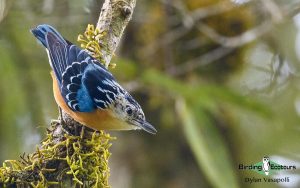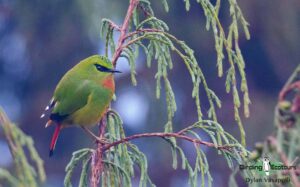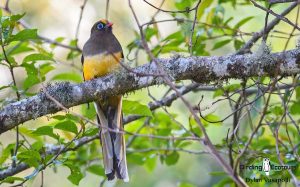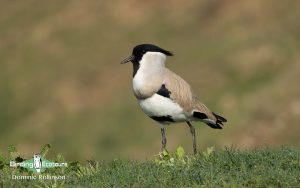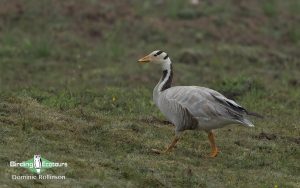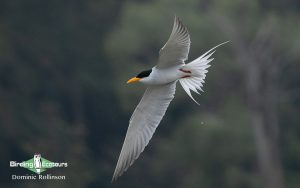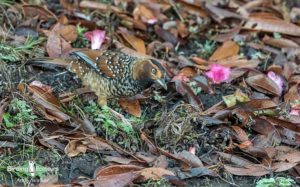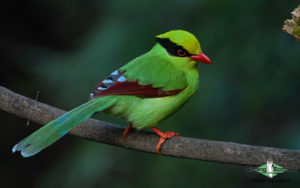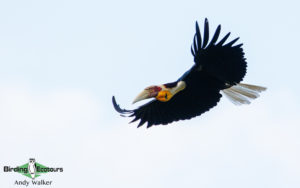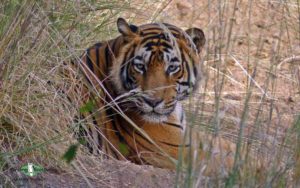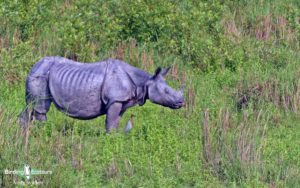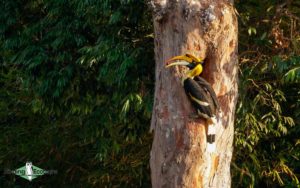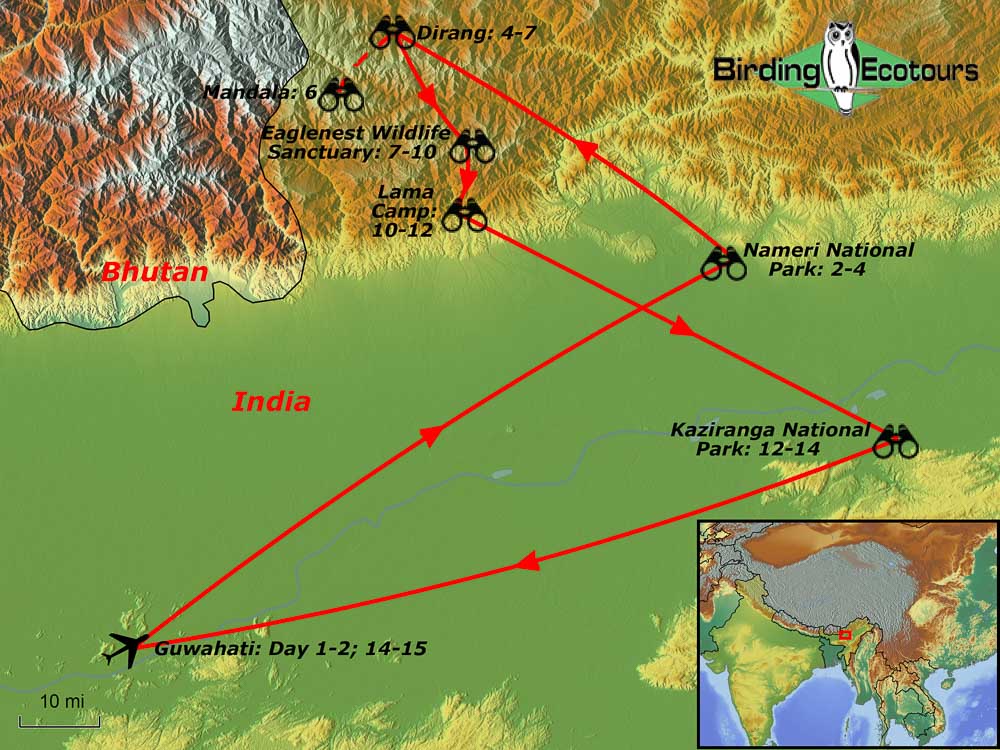Birding Tour India: The Northeast – Spectacular Birds and Mammals
Go to: India Birding Tours | Birding Tours in Asia | All our birding tours
Birding Tour India: The Northeast – Spectacular Birds and Mammals
April 2026/2027
This small-group birding tour of northeast India visits some spectacular scenery in the eastern Himalayas and the floodplain of the mighty (and extremely lengthy) Brahmaputra River, long before it joins the River Ganges in Bangladesh. The mountains and floodplains here are two of the most biologically diverse places in India, and our tour will focus on these areas.
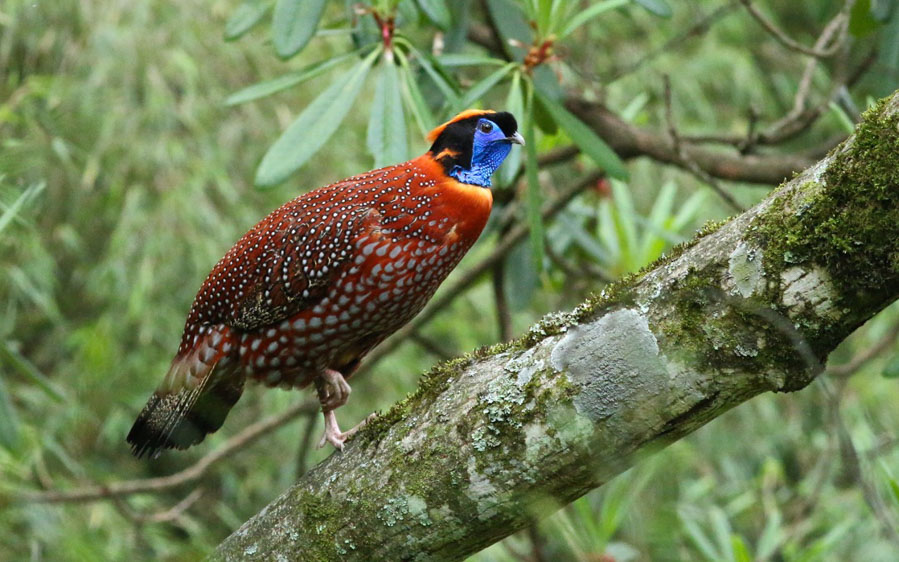 Temminck’s Tragopan is one of our stunning target birds on this trip (photo Summer Wong).
Temminck’s Tragopan is one of our stunning target birds on this trip (photo Summer Wong).
We start this exciting tour in the largest city in Assam, Guwahati, situated on the bank of the Brahmaputra River. From here, we will head into the undisturbed wilderness of the Himalayan foothills of Nameri National Park. This area protects numerous species, and we will look for special birds including at least two that are classified as Endangered by IUCN, Greater Adjutant and White-winged Duck (a secretive forest duck). Nameri also hosts many other interesting birds, such as Great Hornbill, Wreathed Hornbill, Red-breasted Parakeet, Grey-headed Fish Eagle, Great Stone-curlew, River Tern, Small Pratincole, Bengal Bush Lark, and Sand Lark.
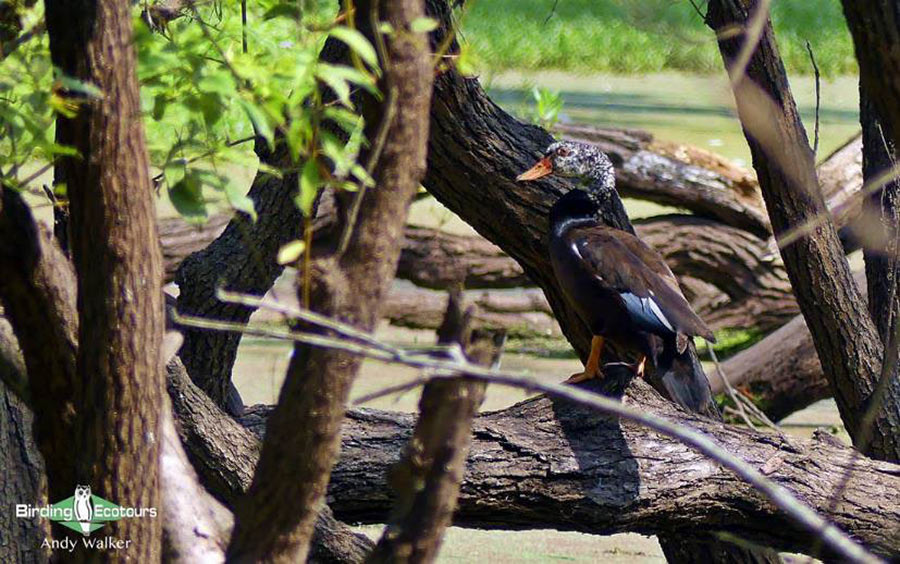
After our stop at Nameri, we will climb into the incredibly beautiful mountains and spend almost a week birding within and around the Eaglenest Wildlife Sanctuary in Arunachal Pradesh, one of the best-known and highly regarded mountain birding sites in the whole of Asia. This is one of our favorite birding destinations in the world. The scenery, forests, and birding here are all spectacular, and we will be looking for some amazing birds such as Temminck’s Tragopan, Blyth’s Tragopan, Blood Pheasant, Snow Partridge, Himalayan Monal, Spotted Elachura, Bugun Liocichla, Ward’s Trogon, Beautiful Nuthatch, Yellow-rumped Honeyguide, Himalayan Cutia, and Fire-tailed Myzornis. We will also look for plenty more gorgeous laughingthrushes, parrotbills, rosefinches, barwings, and related species, with species such as Spotted Laughingthrush, White-breasted Parrotbill, and Rusty-fronted Barwing likely to be some of the highlights. The area is also great for babblers, of which we will seek out many, with Sikkim Wedge-billed Babbler and Bar-winged Wren-babbler being on the opposite sides of the size spectrum. But there is so much more to this area than the brief highlight reel above!
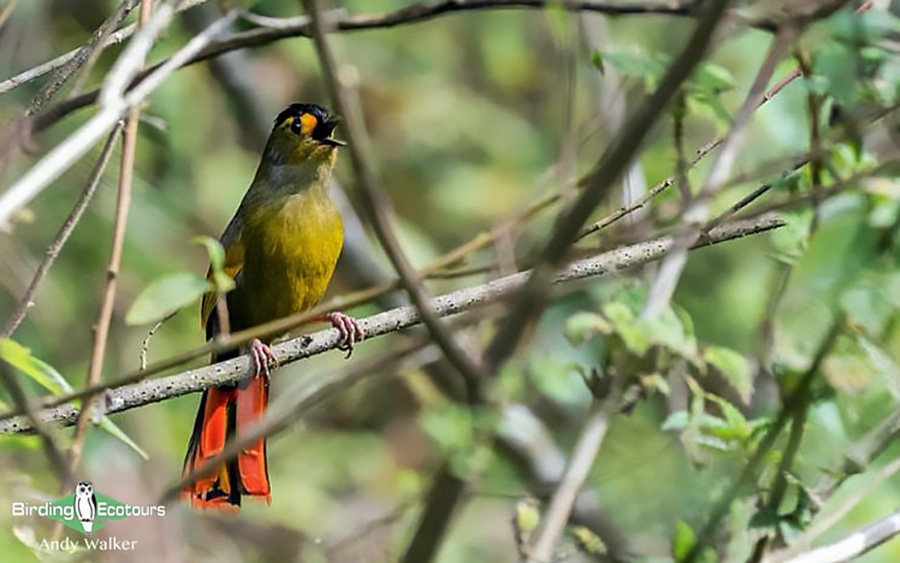
Finally, and gradually, we will descend back down to the Assamese plains of the Brahmaputra, where we will continue our adventure, looking for some difficult yet highly prized species in and around the wondrous Kaziranga National Park. Highlights might include Bengal Florican (rare here now) Greater Adjutant, Lesser Adjutant, Blue-naped Pitta, Indian Grassbird, Swamp Francolin, Black-breasted Weaver, Finn’s Weaver, Dusky Eagle-Owl, Black-necked Stork, Spot-billed Pelican, and Pallas’s Fish Eagle. Once we’ve finished here we will head back to Guwahati where the tour ends.
This tour will also focus on finding some of the major mammals of the region, such as Greater One-horned (Indian) Rhinoceros, Asian Elephant, Barasingha (Swamp Deer), Gaur, Wild Water Buffalo, Indian Leopard, and Western Hoolock Gibbon, along with plenty of more common and widespread species. With extreme luck we may even find Arunachal Macaque, Red Panda, or Bengal Tiger, either one sure to be yet another highlight on this wonderful wildlife-packed tour.
Wallcreeper and Ibisbill both occur in the area of this tour during the winter period (i.e. before this tour occurs). Although seeing them on this tour is considered unlikely (please see this North India bird tour for a great chance of seeing both), we will of course consult with our local team ahead of the tour in case any birds are known to be lingering along our route, in which case we will try and look for them.
Itinerary (15 days/14 nights)
Day 1. Arrival in Guwahati
After your arrival in Guwahati, you will be transferred to our hotel, where the rest of the day will be at your leisure, followed by a group welcome meal.
Overnight: Kiranshree Grand Hotel or similar, Guwahati
Day 2. Transfer to Nameri National Park
After breakfast, we will head to the Guwahati local waste facility, where we should find the humongous (and exceedingly ugly) Greater Adjutant scavenging among the rubbish. We will then continue towards Nameri National Park, looking for Lesser Adjutant at a nest along the way. After checking in at our Nameri hotel, we may find Great Hornbill, Red-breasted Parakeet, Yellow-footed Green Pigeon, Oriental Scops Owl and other goodies.
Overnight: Nameri National Park
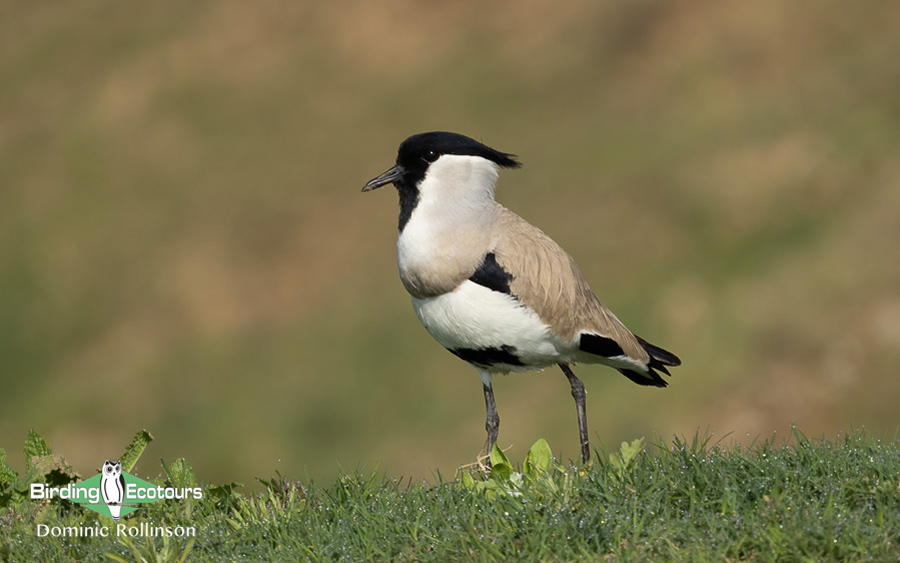
Day 3. Nameri National Park
We will have a morning and afternoon birding session in Nameri National Park (also known as Nameri Tiger Reserve). Nameri is a gorgeous, undulating wilderness area in the foothills of the eastern Himalayas. A large proportion of the national park area consists of swamp forest interspersed with areas of open grassland split up by many river tributaries. Nameri is one of the best places in the world to find the rare, highly elusive, and Endangered (IUCN) White-winged Duck, and this will be one of our major objectives during our time here (sightings are not guaranteed, but we will try!). There is also a small chance of seeing Bengal Tiger here, but there will be better chances for that later in the tour.
There are, however, numerous other great species possible, such as Greater Adjutant, Great and Wreathed Hornbills, Blue-bearded Bee-eater, Pied Falconet, Pied Harrier, Oriental Hobby, White-browed Piculet, Pale-chinned Blue Flycatcher, and Black-backed Forktail. A boat ride along the river here might produce some highly sought species such as Small Pratincole, River Tern, River Lapwing, Great Stone-curlew, Sand Lark, Striated Grassbird, and the huge Crested Kingfisher. We will make sure to try to find as many of these as possible during the day and during the following morning before leaving the area.
Overnight: Nameri National Park

Day 4. Nameri National Park to Dirang
After a morning birding session in the Nameri National Park we will head toward Dirang. This part of India is one of the most diverse in the country due to the huge gain in elevation of the Eastern Himalayas in a relatively small area, e.g. sea-level to 7,000 meters (22,650 feet) in about 150 kilometers (93 miles). We will pass through some gorgeous scenery and a wide range of habitats as we make our way up to the 1,500 meters (5,259 feet) elevation zone. Over the course of our journey and the rest of the afternoon we may find Rufous-bellied Eagle, Northern Goshawk, Pied Falconet, Hill Partridge, Golden-throated Barbet, Grey-chinned Minivet, Blue-fronted Robin, Little Forktail, Golden Bush Robin, Rufous-breasted Bush Robin, Green Cochoa, Purple Cochoa, Long-tailed Broadbill, Scaly Laughingthrush, Coral-billed Scimitar Babbler, Slender-billed Scimitar Babbler, Himalayan Cutia, Black-headed Shrike-babbler, Green Shrike-babbler, White-naped Yuhina, White-breasted Parrotbill, Pale-billed Parrotbill, and Sultan Tit.
Overnight: Dirang
Day 5. Birding the Sela Pass and Sangti Valley
Today will be a very exciting and memorable day as we visit a wide range of habitats and elevations. After an early start we will head up to around 4,200 meters (14,108 feet) on the famous Sela Pass – one of the highest drivable mountain passes in all of the Himalayas. Here in the alpine meadows, we will focus on some very special, highly sought, and seriously stunning montane species such as Blood Pheasant, Snow Partridge, Himalayan Monal, Himalayan Vulture, Snow Pigeon, Grandala, Hodgson’s Redstart, Alpine Accentor, Tibetan Serin, Plain Mountain Finch, Himalayan White-browed Rosefinch, Spotted Laughingthrush, Rufous-breasted Bush Robin, and White-browed Tit-warbler
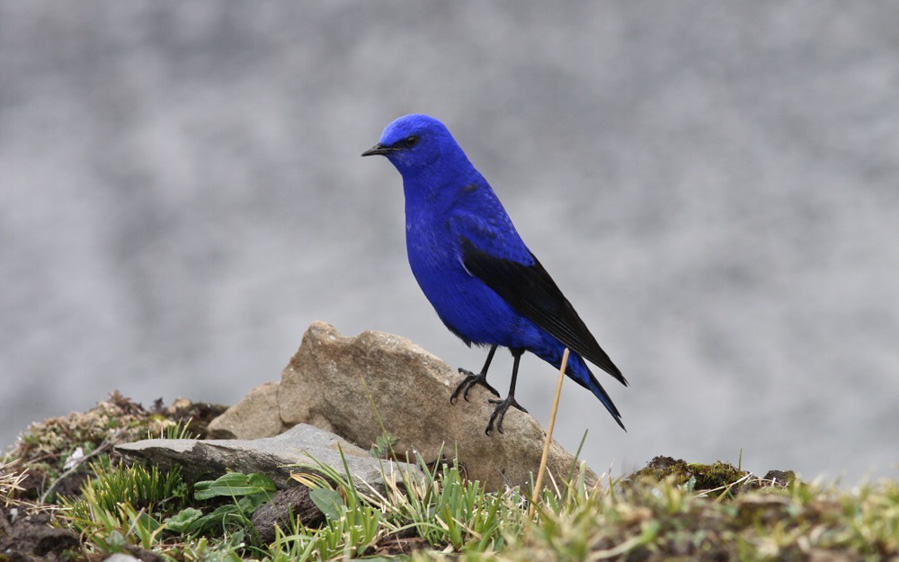
It is certain to be a memorable morning’s birding, and the afternoon is sure to be just as good as we will visit the Sangti Valley at an altitude of around 1,500-1,600 meters (4,920-5,413 feet), where we will look for several equally exciting species as those possible during our morning birdwatching session, such as the secretive Black-tailed Crake, and the uncommon Long-billed Plover. Other interesting species in the valley at this time of year include Rosy Pipit, Olive-backed Pipit, Yellow-breasted Greenfinch, Brown Dipper, and the stunning White-capped Redstart, Little Forktail. There is a good chance that the ‘bird of the trip’ may be found today, because the quality of birds on offer is so high! We will end the day in Dirang.
Overnight: Dirang
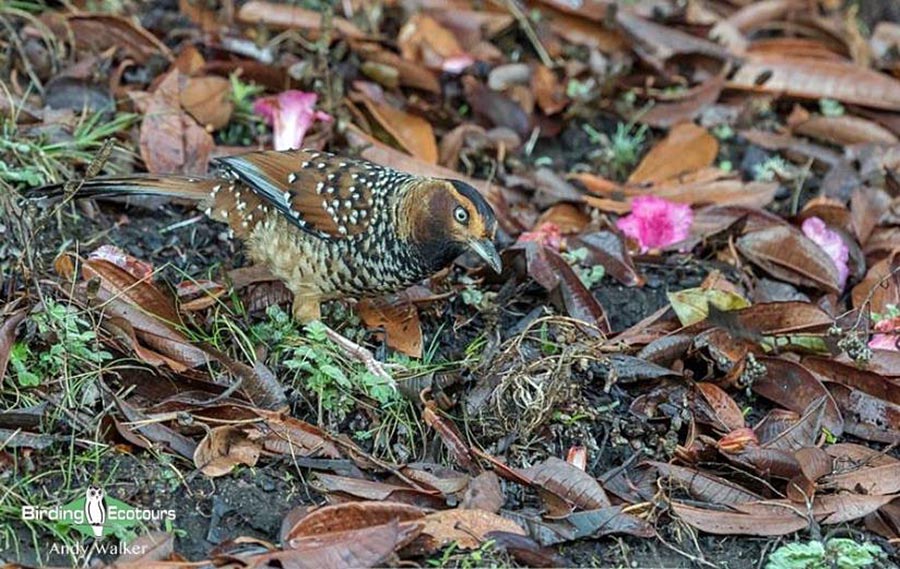
Day 6. Mandala birding
We will spend the full day birding around Mandala. Target species are plentiful and may include one of the world’s best-looking birds, Temminck’s Tragopan. It is scarce here, but we will certainly be putting a great deal of effort into trying to find it. There will be plenty of other species in the forests here, such as Blanford’s Rosefinch, Bhutan, Black-faced, and Spotted Laughingthrushes, Gould’s Shortwing (with luck, if they have arrived), Fire-tailed Myzornis, White-collared and Grey-winged Blackbirds, Grey-headed Bullfinch, Crimson-breasted Woodpecker, Rufous-breasted and Maroon-backed Accentors, Hodgson’s and White-throated Redstarts, Golden-naped Finch, Rufous-fronted Bushtit, Grey Crested Tit, and Spotted Nutcracker. Ward’s Trogon is also a scarce possibility here. We are sure to have another memorable day.
Overnight: Dirang
Days 7-9. Bompu Birding Camp, Eaglenest Wildlife Sanctuary
We will embark on a long drive to Bompu Birding Camp at 1,940 meters (6,364 feet), where we will spend the next three nights at a fully serviced camp inside the wonderful Eaglenest Wildlife Sanctuary. Due to the good access here, we will be able to enjoy three full days’ birding across a wide elevational range to maximize our chances for the most exciting species and mixed-flocks/bird-waves on offer here. Barwings, yuhinas, laughingthrushes, and related species are likely to be evident, such as Red-faced Liocichla, Himalayan Cutia, Fire-tailed Myzornis, Blue-winged Minla, Red-billed Leiothrix, Silver-eared Mesia, Rusty-fronted and Streak-throated Barwings, Long-tailed and Beautiful Sibias, White-naped, Whiskered, and Rufous-vented Yuhinas, Golden-breasted Fulvetta, and Blue-winged, Bhutan, and Black-faced Laughingthrushes. Beautiful Nuthatch and Rusty-flanked Treecreeper along with Yellow-cheeked and Sultan Tits are likely to be in the bird-waves. A range of parrotbills too could be on offer, with Black-headed, Pale-billed and Brown Parrotbills all possible. Some color and further quality might be provided by Ward’s Trogon, Red-headed Trogon, Yellow-billed Blue Magpie, Rufous-necked Hornbill, and Scarlet Finch.
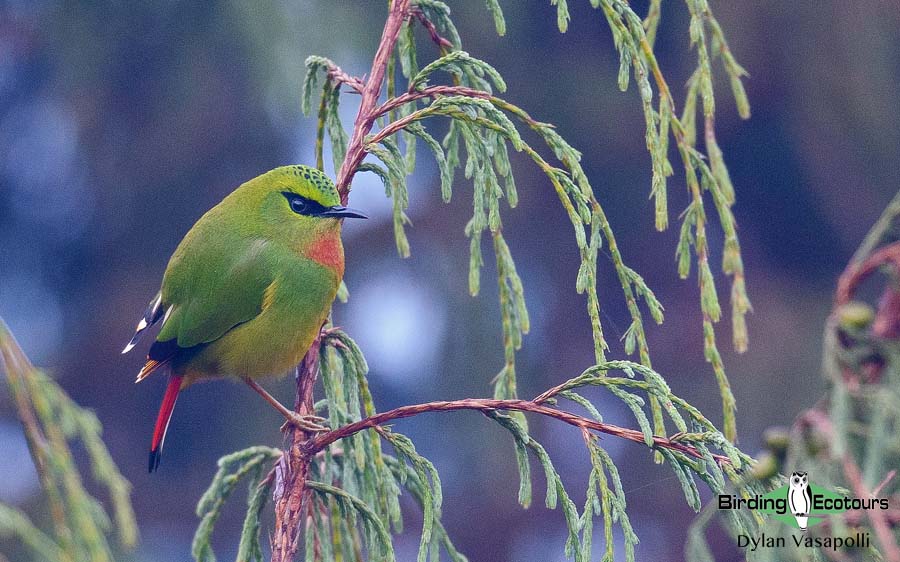
By spending a few days here we will be able to concentrate our efforts on some of the more secretive and skulking but highly rewarding species such as Spotted Elachura (a recent elevation to monotypic family status), Gould’s Shortwing (with luck, if they have arrived), Grey Peacock-Pheasant, Chestnut-breasted Partridge, Hodgson’s Frogmouth, Blyth’s Kingfisher, Brown Wood Owl, Speckled Wood Pigeon, Darjeeling Woodpecker, Black-faced Warbler, Chestnut-headed Tesia, White-browed Bush Robin, Golden Bush Robin, Long-tailed and Himalayan Thrushes, and another possible ‘bird of the trip’, the shy and difficult but totally worth-the-effort Blyth’s Tragopan. Two mammals we will be looking for here are the very rare and both Endangered (IUCN) Red Panda and Arunachal Macaque; with luck we may find one or even both of these in the forests.
Overnight: Bompu Birding Camp
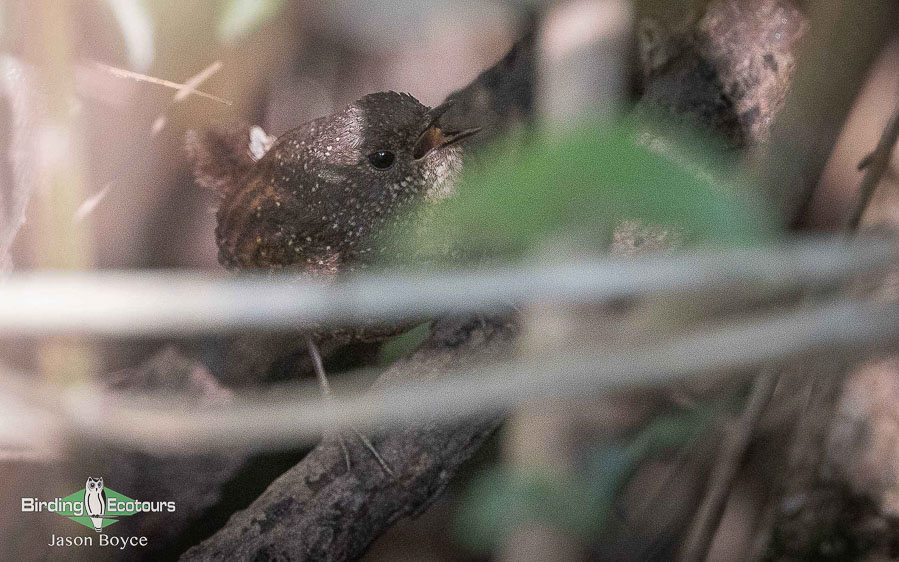
Day 10-11. Lama Camp, Eaglenest Wildlife Sanctuary
We will bird a large chunk of Eaglenest on the exciting mountain road between Bompu Birding Camp and Lama Camp, where we will spend two nights.
The recently discovered Bugun Liocichla is one of our main targets here. Some of the other thrilling birds we will try and find include Blyth’s Tragopan and Temminck’s Tragopan (two very impressive, but scarce and often shy birds) along with Himalayan Bluetail, White-browed (Blyth’s) Shrike-babbler, Brown-throated and Golden-breasted Fulvettas, Himalayan Cutia, Stripe-throated Yuhina, Rusty-fronted and Streak-throated Barwings, Himalayan Thrush, Rufous-chinned and Grey-sided Laughingthrushes, Fulvous and Black-throated Parrotbills, Slender-billed and Streak-breasted Scimitar Babblers, and Green-tailed Sunbird.
Overnight: Lama Camp
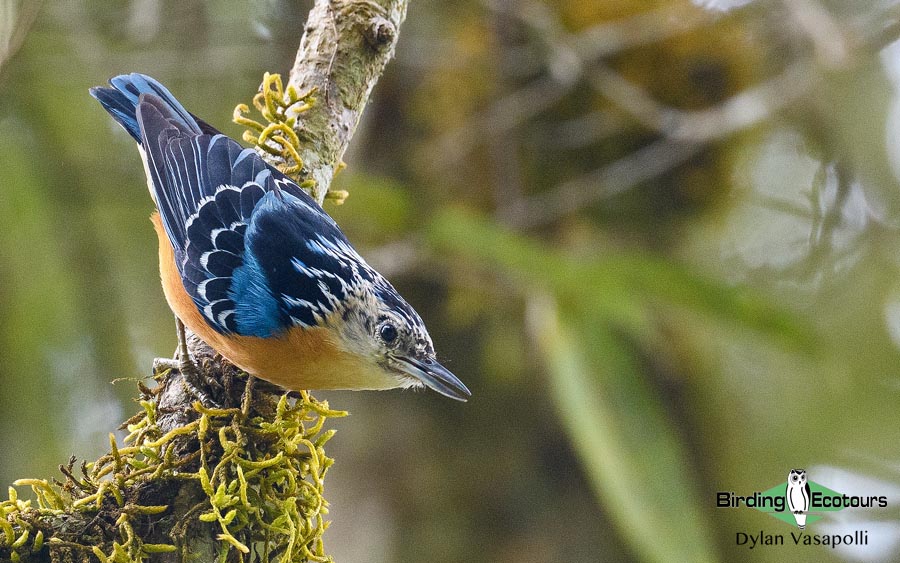
Day 12. Lama Camp to Kaziranga National Park
Today we will start our descent from the mountains to the Assamese plains. Leaving Lama Camp we will drop down to the famous and huge Kaziranga National Park in central Assam, eventually crossing the mighty and equally famous Brahmaputra River. Indeed, the national park is the largest undisturbed area of the river’s floodplain and a spectacular sight in its own right, stacked full of jaw-dropping wildlife. This is one area of India that is a ‘must-visit’ for any birder and wildlife lover.
After the very basic accommodation at Eaglenest, we stay at a comfortable hotel in Kaziranga.
Overnight: Iora Niltava, near Kaziranga National Park
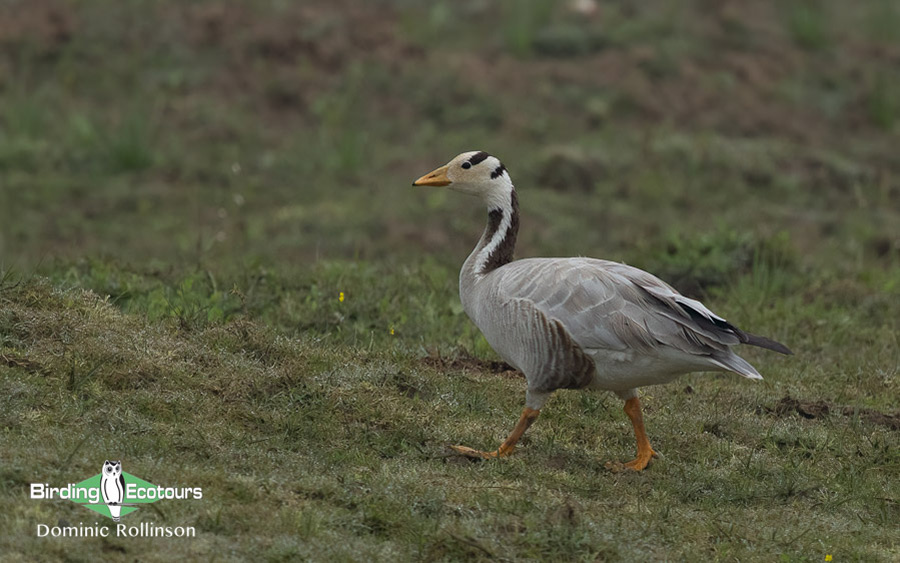
Day 13. Kaziranga National Park
This morning, we’ll enjoy our first Kaziranga National Park safari (as game drives are called in India). During this safari, a major target will be the pre-historic-looking Greater One-horned (Indian) Rhinoceros (this is the only place in the world to see this huge and incredibly impressive species reliably).
Some very special birds are possible today, and we will look for Bengal Florican (but it is now rare here), Greater Adjutant, Blue-naped Pitta, Indian Grassbird, Swamp Francolin, Spot-billed Pelican, and Pallas’s Fish Eagle. However, while looking for the above species (and the mammals referenced below) there are plenty of other birds for which we will keep an eye out as we make our way through various open grasslands and wetlands of the area, such as Black-necked Stork, Painted Stork, Asian Woolly-necked Stork, Black Stork, Asian Openbill, Cotton Pygmy Goose, Bar-headed Goose, Grey-headed Lapwing, Alexandrine and Red-breasted Parakeets, Grey-headed Fish Eagle, Zitting Cisticola, Chestnut Munia, Red Avadavat, Bengal Bush Lark, Finn’s Weaver, Baya Weaver, Streaked Weaver, Black-breasted Weaver, and Spot-winged Starling.
The more scrubby and wooded areas in and around the national park hold Siberian Rubythroat, Common Green Magpie, Kalij Pheasant, Red Junglefowl, Common Emerald Dove, White-rumped Shama, Rufous Woodpecker, Grey-headed (Black-naped) Woodpecker, Fulvous-breasted Woodpecker, Speckled Piculet, White-browed Scimitar Babbler, Greater Necklaced, Lesser Necklaced, and Rufous-necked Laughingthrushes, Maroon Oriole, Blue-eared Barbet, Great Barbet, Verditer Flycatcher, and Smoky Warbler.
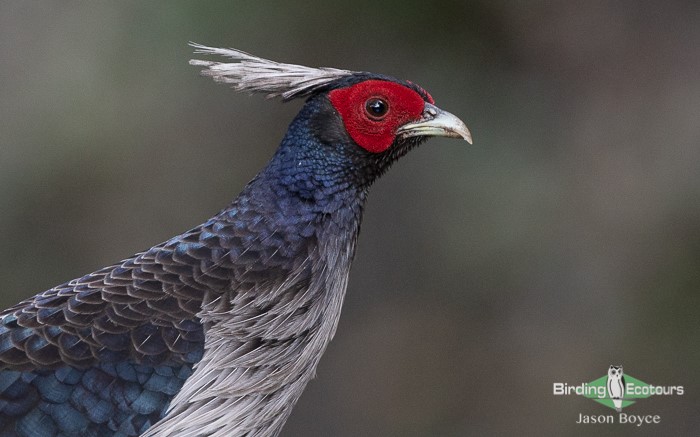
A fine suite of mammals also occurs in Kaziranga National Park, and we will look for Greater One-horned (Indian) Rhinoceros, Asian Elephant, Gaur, Wild Water Buffalo, Barasingha (Swamp Deer), Sloth Bear, and Western Hoolock Gibbon. With some luck we may even come across the rare and secretive Bengal Tiger, Indian Leopard, Clouded Leopard, Jungle Cat, Fishing Cat, or Leopard Cat while here. Our visit in and around this national park is sure to be a very interesting, bird-and-wildlife-packed time.
Overnight: Iora Niltava, near Kaziranga National Park
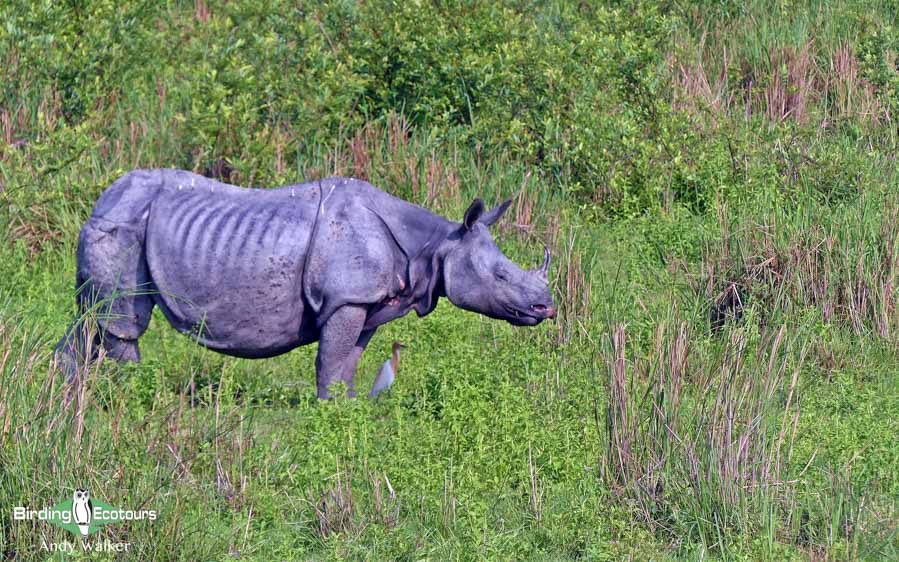
Day 14. Kaziranga National Park to Guwahati
After a final birding session at Kaziranga looking for any of the aforementioned species we might still be looking for, or would like to try and see again, we will head back to Guwahati.
Overnight: Kiranshree Grand Hotel or similar, Guwahati
Day 15. International departure
This is a non-birding day with departure from Guwahati.
Overnight: Not included
Please note that the itinerary cannot be guaranteed as it is only a rough guide and can be changed (usually slightly) due to factors such as availability of accommodation, updated information on the state of accommodation, roads, or birding sites, the discretion of the guides, and other factors. In addition, we sometimes have to use a different guide from the one advertised due to tour scheduling or other factors.
Download ItineraryIndia – The Northeast: Set Departure Birding Trip Report, February 2024
26 FEBRUARY – 11 MARCH 2024
By Chris Lotz
DOWNLOAD TRIP REPORT
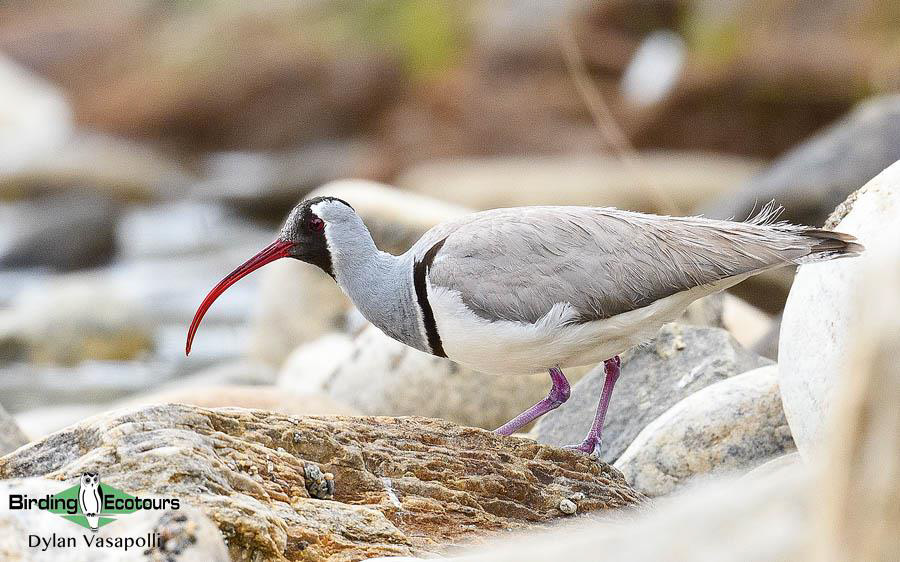
Ibisbill was one of three monotypic family birds we found on this tour
Overview
Northeast India is one of the best places for finding Ibisbill, Wallcreeper and Spotted Elachura. These three species are the only members of their families, and are therefore sought-after by bird family listers, like the three participants on this tour. Thankfully, we found these major targets. This part of the world is also excellent for a suite of Himalayan foothill forest bird species such as Beautiful Nuthatch, Yellow-rumped Honeyguide, Fire-tailed Myzornis, Himalayan Cutia and many other star birds; we saw the four mentioned above really well. The Sela Pass provides easy access to sought-after high altitude Himalayan birds like the luminous Grandala, Blood Pheasant and various rosefinches, all of which we enjoyed seeing on this tour.
In stark contrast to all these mountain species, the Assamese Plains on either side of the massive Brahmaputra River provide refuge for big mammals including Greater One-horned (Indian) Rhinoceros, Asian Elephant and many others, along with a rich assemblage of bird species.
All in all, this was a tour with spectacular, varied scenery, lots of birds, and brilliant mammals which also included an unexpected Marbled Cat in Nameri National Park.
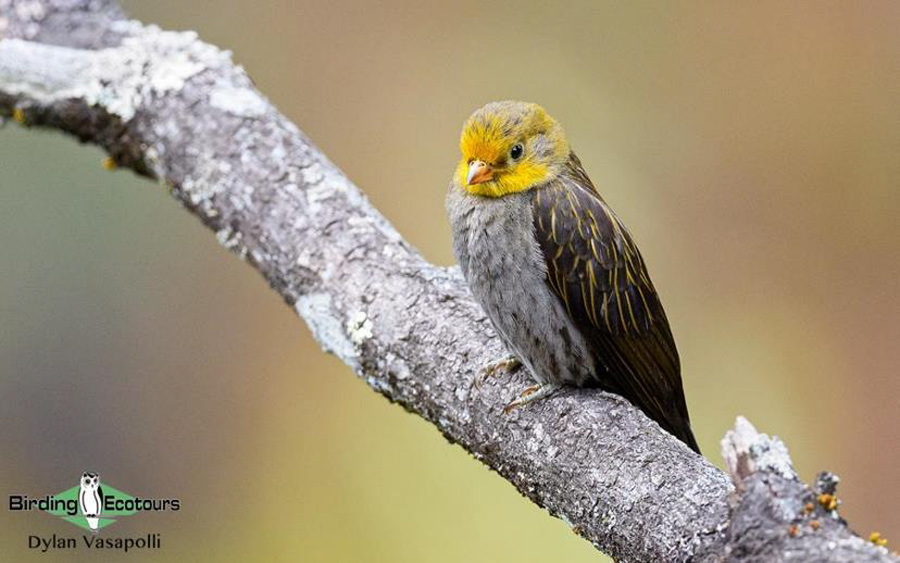
Yellow-rumped Honeyguide showed well towards the end of the tour
Detailed Report
Day 1, 26th February 2024. Arrival in Delhi and birding Lodi Gardens
John and I had arrived the previous day, so we had time to bird the Lodi Gardens in Delhi for a couple of hours this afternoon (the other tour participants arrived this afternoon and opted out of this introductory birding session). Before heading there, we enjoyed seeing some very tame Bank Mynas just outside the hotel, a nice species to see compared to the ever-abundant Common Mynas that are literally everywhere.At the Lodi Gardens, we enjoyed seeing some great birds such as Brown-headed Barbet, Indian Grey Hornbill, Yellow-footed Green Pigeon, White-breasted Waterhen, Red-naped Ibis, Indian Pond Heron, Common Tailorbird, personality-filled Jungle Babbler, large numbers of Rose-ringed Parakeets and a handful of their larger relatives, Alexandrine Parakeets. These gardens are a fascinating place to visit not only for birds, but also to see the 15th century Lodi dynasty tombs. After our visit to the park, we went to the Khan Market before heading back to our hotel for dinner and to get some rest for our flight to Assam the next day.
Day 2, 27th February 2024. Flight to Guwahati and transfer to Nameri Tiger Reserve
This was mainly a travel day. After arrival in Guwahati in the late morning, we immediately visited the Deepor Beel Garbage Dump. This is not a pleasant place to visit but is famous in birding circles. Indeed, we were rewarded with close-up sightings of the rare and localized Greater Adjutant, among impressive numbers of Black Kites and Eastern Cattle Egrets.
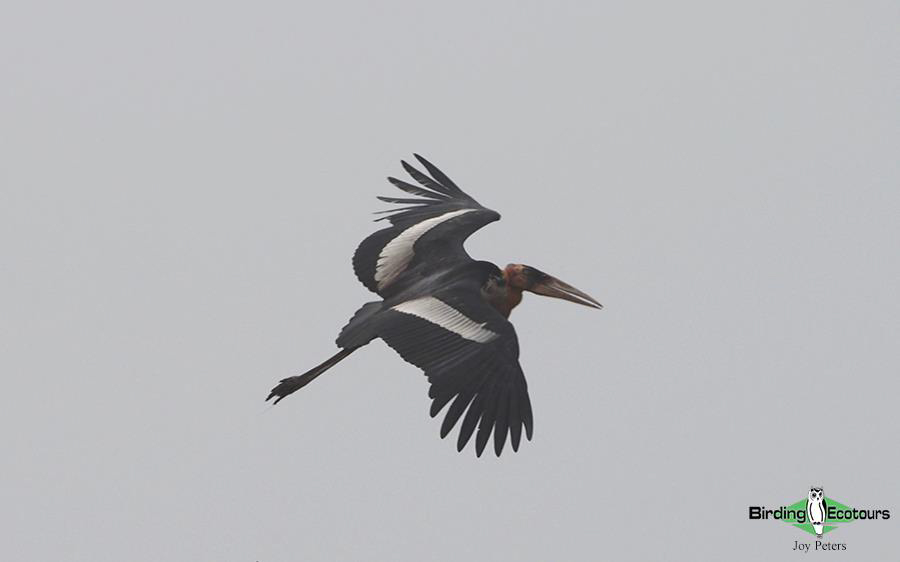
The huge Greater Adjutant.
We then continued our journey, making some brief birding stops along the way, one of them being at some Lesser Adjutant nests so we could compare this species with its larger relative. A Cinereous Tit, singing alongside the adjutant nests, showed well.
With much anticipation about the next day’s birding, we arrived at Baligara Camp, Nameri National Park (aka Nameri Tiger Reserve) and checked in for our two-night stay.
Day 3, 28th February 2024. Birding Nameri National Park
This morning, we were distracted by a flowering Coral Tree that was attracting many excellent birds, including Lineated Barbet, Blue-throated Barbet, Green Imperial Pigeon, Chestnut-tailed Starling and a few others. This slightly delayed our morning visit to Nameri where, upon stopping at the park office, we got great views of some Capped Langurs, always a good-looking monkey to see.
Our main birding site for the morning was Jia Bhoroli Camp, where we amassed 50 bird species. One of the biggest highlights of this session was, however, seeing a mammal, not a bird, in the form of a Marbled Cat crossing the trail in front of us, wow! We also saw and heard Northern Red Muntjac (Barking Deer). Bird-wise, the pickings included a couple of Peregrine Falcons which we scoped, Red Junglefowl (ancestors of domestic chickens), Barred Cuckoo-Dove, Green-billed Malkoha, Indian Stone-curlew, some nice woodpeckers in the form of Greater Flameback and Fulvous-breasted Woodpecker, Red-breasted Parakeets feeding on Coral Tree flowers, and three species of colorful minivets: Scarlet, Short-billed and Grey-chinned Minivets. The unusual Maroon Oriole showed well, albeit briefly, as did Black-naped Monarch, Small Niltava, Pale-chinned Flycatcher and a fabulous Little Pied Flycatcher. A White-capped (Water) Redstart was yet another of many extremely colorful birds we saw. Abbott’s Babbler, many Pin-striped Tit-Babblers and a host of other species kept us busy until we had to head back for lunch.
After lunch, we went rafting on the Kameng River. Our most important target, which we saw very well near the start of the session, was the unique Ibisbill. This bizarre wader is in its own family and hence sought after by family listers, like the participants on this tour. We enjoyed getting close views of four individuals. We also loved seeing the spectacle of hundreds of Small Pratincoles, such striking birds in flight with their pied wing pattern; they are more subtle when resting on the bank. A pair of massive-billed Great Thick-knees were a real highlight. This is truly an impressive-looking species and we saw them pretty close-up. A range of other great birds put in appearances along the bank, including beautiful River Lapwings, really close-up Little Ringed Plover, Common Greenshank, Green Sandpiper, Common Sandpiper, Sand Lark, Siberian Stonechat and three kingfisher species. Many pairs of Ruddy Shelducks, and smaller numbers of Eurasian Teals, Common Mergansers and a few other ducks, were in evidence. Flocks of Little Cormorants and the occasional Great Cormorant were also around. Sand Larks showed now and again, and there were also a couple flocks of Rosy Pipits, with one individual in beautiful pink breeding plumage. A couple of brightly-colored Indochinese Rollers sat conspicuously on open perches as we rafted by. An Asian Openbill flew past at one point.
After our very successful session on the river, we made a short birding stop on our way back to our lodgings. This did not disappoint, as we added some good trip birds like Black-winged Cuckooshrike, our first of many Dusky Warblers, Red-wattled Lapwing, Rufous Treepie,more Greater Flamebacks and a new woodpecker, Black-rumped Flameback.
Before dinner, we did a 45-minute-long owling session, seeing Brown Boobook (Brown Hawk-Owl) nicely. We heard two other owl species but were unable to lay eyes on them.
Day 4, 29th February 2024. Climbing in altitude from Nameri to Dirang
At breakfast time, we found more good birds around our lodgings, the highlight being Taiga Flycatcher. We then began our drive towards the mountains, soon entering the state of Arunachal Pradesh (and saying goodbye to Assam for a few days). Shortly after crossing the state line, we scoped a stunning pair of Oriental Hobbies and a brightly-colored Chestnut-headed Bee-eater.
We then rapidly started climbing higher and higher into the Himalayan foothills, reaching 6,000 feet (1,830 meters) at the highest point before later descending a little to Dirang, which would be our base for the next three nights. We soon entered the bamboo zone where we obtained good views of a few Yellow-bellied Warblers.
Further up, we scoped some birds far down in the river below us. These included some attractive species like Slaty-backed Forktail, White-capped (Water) Redstart, Plumbeous Water Redstart and Blue Whistling Thrush. Another stream-associated bird, Grey Wagtail, visited us right on the road. Also very close to the road, but remaining well-hidden most of the time, was a beautiful but elusive Chestnut-headed Tesia. We got excellent views of a male Black-throated Sunbird, whileon the slope between the road and the river, we scoped a female Blue Rock Thrush. In the scrubby hillside, we enjoyed looking at a mobile flock of Silver-eared Mesias, another really colorful species.
Driving further and stopping for roadside birding along the way generated new trip birds like a scoped Mountain Hawk-Eagle, a Buff-barred Warbler, Blyth’s Leaf Warblers, a female Blue-fronted Redstart and a flock of Whiskered and White-naped Yuhinas.
Our lunch stop was arguably the best birding stop yet. While we waited for lunch to be prepared, we got close views of a handful of Little Buntings, while a Black-throated Prinia also co-operated well. A showy Rufous-gorgeted Flycatcher provided a nice comparison with the similar Taiga Flycatcher we’d seen earlier. We also found a number of other nice species like Green-backed Tits, a Grey-headed Canary-flycatcher, a female Hodgson’s Redstart, some Olive-backed Pipits and another Dusky Warbler. A couple of Eurasian Tree Sparrows were also around.
We then went to a site along the Tenga River to look for Long-billed Plover and we weren’t disappointed! This enigmatic plover breeds on mountain rivers with shingle islands and banks, a habitat shared with Ibisbills, and indeed we saw a dozen of these too. We also saw some other great birds, such as Red-wattled Lapwings,a showy Brown Dipper, good numbers of White Wagtails (at least three subspecies), a couple of White-browed Wagtails, a Grey Wagtail and various other bird species we had already seen.
Our last stop just before reaching our hotel was a site for the stunning Wallcreeper, and this charismatic species co-operated awesomely; we could not have asked for better views!
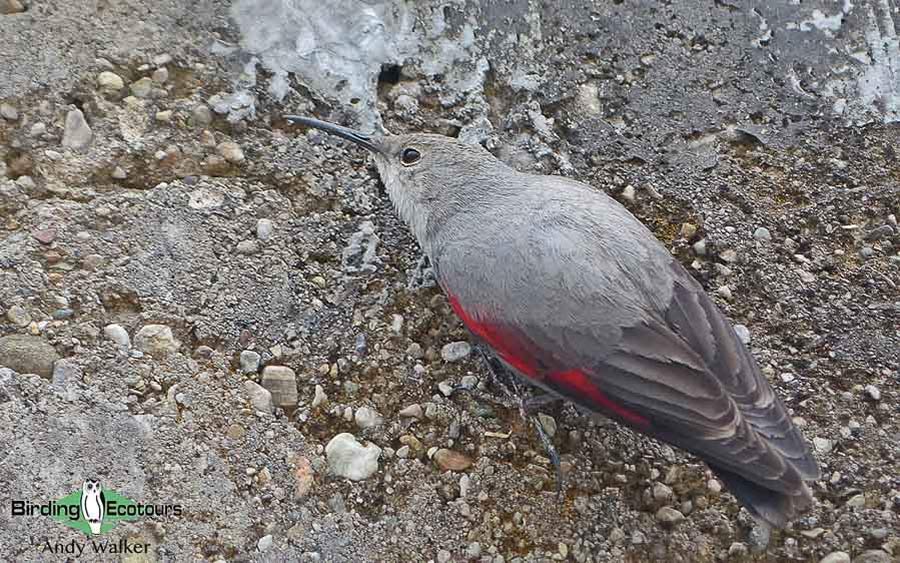
Wallcreeper was one of three monotypic family birds we were looking for on this tour
Day 5, 1st March 2024. High altitude birds of the Sela Pass
We had a 4 am start to head to 14,108 feet (4,200 meters), where we were able to find star birds against the backdrop of spectacular Himalayan scenery. The vividly blue Grandala did not disappoint, and neither did the beautiful Blood Pheasant. White-browed Tit-warbler was another real highlight, as were the dapper Snow Pigeons thatwere around. The high altitude is great for rosefinchspecies and we saw Dark-breasted, Himalayan White-browed and Red-fronted Rosefinches. We also saw the much less colorful Plain Mountain Finch. Alpine Accentor and Alpine Chough were also around, and during the drive up, there were good numbers of Eurasian Nutcracker, a White-collared Blackbird and a spectacular Yellow-billed Blue Magpie.The charismatic Spotted and Black-faced Laughingthrushes were quite entertaining, and we were also treated to a magnificent Bearded Vulture.In the afternoon, we tried finding Black-tailed Crake but only heard it.
Day 6, 2nd March 2024. Birding Mandala
We spent most of the day birding Mandala, up to about 10,500 feet (3,200 meters). Three Black Eagles, a Shikra dashing below us and a Himalayan Vulture were all good to see. We scoped fabulous-looking Red-headed and Grey-headed Bullfinches and unusual female Golden-naped Finch.We enjoyed seeing a lot of Russet Sparrows at breakfast time near the top, and a close-up pair of Darjeeling Woodpeckers co-operated nicely. Several striking tit species with crests were around: Grey-crested Tit, Coal Tit (of the crested subspecies), Rufous-vented Tit and the colorful Yellow-cheeked Tit. Black-throated Bushtit also provided a splash of color in a tree full of equally bright Black-faced Warblers. In another area, there was a tree full of Ashy-throated Warblers. Personality-filled Black-faced and Chestnut-crowned Laughingthrushes were also around. A couple of Green Shrike-babblers were next to show themselves to us. An exciting mixed flock contained several Brown Parrotbills, Brown-throated Fulvettas and, unexpectedly, Manipur Fulvettas (the latter was a lucky find). Our first of many flocks of Beautiful Sibias wowed us, as did a flock of Stripe-throated Yuhinas. We found our first Himalayan Bluetails, a couple of White-browed Bush Robins,which proved challenging to see and a couple of vibrant Green-tailed Sunbirds.
Day 7, 3rd March 2024. Birding Mandala again before transferring to Eaglenest Wildlife Sanctuary
We started the day with some productive birding just above Dirang. Highlights included Grey-backed Shrike, Grey Bush Chat, Tibetan Serin, Daurian Redstart and several Blue-fronted Redstarts, Chestnut-bellied Rock Thrush, Large Hawk-Cuckoo, Fire-breasted Flowerpecker and the scarce Yellow-bellied Flowerpecker. We also saw our first Black Bulbuls, and several warblers including new ones like Grey-hooded Warbler, Grey-flanked Bush Warbler and Grey-sided Bush Warbler.
Ascending towards Mandala again, we found some mixed flocks containing new trip birds like Golden-breasted Fulvetta, Rufous-capped Babbler, Streak-breasted Scimitar Babbler and others. A small flock of Crimson-browed Finches also co-operated well.
Beyond Mandala, we made further birding stops all along the way to Lama Camp, the gateway to Eaglenest Sanctuary. We added quite a number of bird species to our growing list. These included Rufous-vented Yuhina, Rufous-breasted Accentor, Bar-throated Minla, Red-tailed Minla and Golden-throated Barbet.
We reached Lama Camp at dusk, eagerly anticipating further great birding.
Day 8, 4th March 2024. Our first Eaglenest area birding
We started the day birding the Singchung Bugun Community Reserve and nearby areas. Exciting mixed species flocks were much in evidence in the early morning. These contained Golden Babbler, Bhutan Laughingthrush, Rusty-fronted Barwing, Bar-throated Minla, and various other species we’d seen earlier in the trip.
Good-looking Striated and Black Bulbuls were very vocal and at times showed well. At one point, a White-tailed Nuthatch sat on a rock (trying to be a rock nuthatch) and showed well. We scoped a nice Rufous-bellied Woodpecker. We found both Black-throated and Rufous-fronted Bushtits, the latter being new for the trip. A few lovely Grey-winged Blackbirds provided brief views.
It was an awesome morning for raptors, with a beautiful pair of Mountain Hawk-Eagles putting on a show, and three accipiter species in the form of Crested Goshawk, Eurasian Sparrowhawk and our second Shikra of the trip.
After breakfast, we embarked on the long drive to Bompu Birding Camp, which ended up taking five hours with all the birding stops! This proved to be productive, and we gradually added new species to our growing trip list all along the scenic mountain road. As is typical for them, a pair of highly vocal Bay Woodpeckers only gave us flight views, always hiding out of site when perched. We gratefully accepted this as it’s better than not seeing the species at all! We also saw our first Great Barbet for the trip, a real whopper of a barbet, being roughly a foot-long! While walking along a trail, we startled a female Blyth’s Tragopan which quickly vanished after brief views, but tantalizingly, creating hope that we would lay eyes on a gorgeous male at some point. John saw a Scaly-breasted Cupwing just as we were getting into the vehicles to drive off, but the rest of us only heard it. We saw a lot of old friends we had already seen before, plus some new trip birds like Hoary-throated Barwing and a mobile flock of White-throated Laughingthrushes. We then settled in to our accommodation at Bompu Camp, where we would be based for the next three nights.
Day 9, 5th March 2024. Eaglenest Wildlife Sanctuary birding
Early this morning we saw a few Hill Partridges and Kalij Pheasants on the road in front of us. We also saw good numbers of all three Barwings, namely Hoary-throated, Streak-throated and Rusty-fronted. Additionally, we encountered a flock of Yellow-throated Fulvettas and groups of Striated and Grey-sided Laughingthrushes. A Long-tailed Thrush showed well right next to the road, and we also scoped a flock of nine Brown Bullfinches. The highlight of the morning, and indeed the day, was an extremely co-operative and beautiful Fire-tailed Myzornis feeding on tree sap in a stand of bamboo.
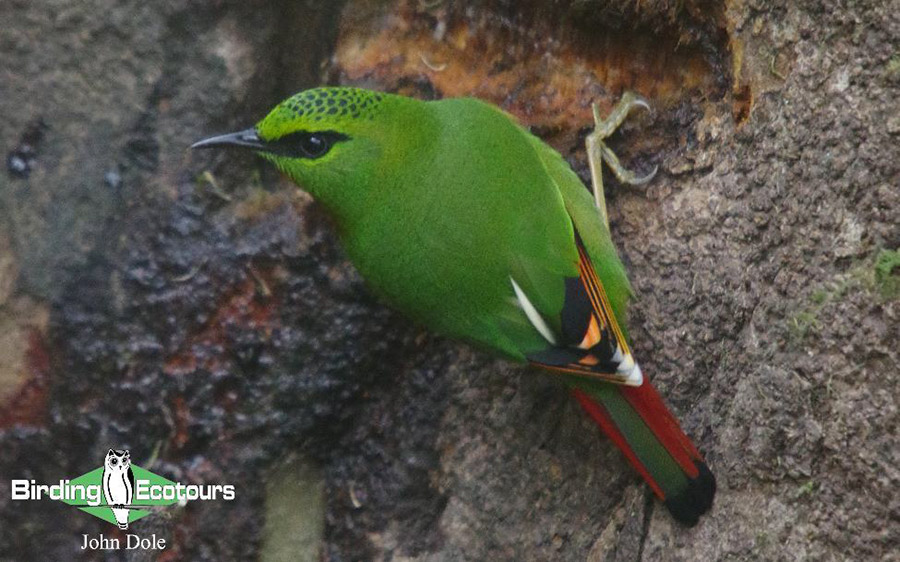
Fire-tailed Myzornis feeding on sap
The afternoon birding below Bompu Camp was spectacular. It didn’t take us long to find a mixed flock containing Beautiful Nuthatch, White-browed and Black-headed Shrike-babblers and various other goodies. As we descended to lower altitude, we were very pleased to see five Sikkim Wedge-billed Babblers, each one stopping besides the road before flying off, one after the other. Other new trip birds included a Greater Yellownape, a few Long-tailed Sibias, a spectacular Lesser Racket-tailed Drongo and others. Our first of many Yellow-bellied Fantails put on an awesome show and a White-throated Fantail made a brief appearance for comparison. No less than five Spotted Elachuras were vocal at various points in the afternoon, but only one of them allowed brief views, this afternoon and again the next morning. The elachura was the third and final monotypic family bird we needed on this tour.
We also heard Asian Elephants trumpeting in the distance, and saw their signs along the road.
Day 10, 6th March 2024. Another full day around Bompu Birding Camp, Eaglenest Wildlife Sanctuary
We birded quite an altitudinal range from 6,400 feet (about 1,960 meters), down to 2,900 feet (890 meters). As we descended, we found a couple of Red-headed Trogons, some Emerald Doves on the road, Red Junglefowl, Kalij Pheasants and some exciting mixed species flocks. Good birds in the mixed flocks included a group of six Beautiful Nuthatches, Black-eared Shrike-babbler, White-breasted Parrotbill, Black-crowned Scimitar Babbler, Rufous-winged Fulvetta, White-bellied Erpornis, Blue-winged Minla, Red-faced Liocichla, Sikkim Treecreeper, Chestnut-crowned Warbler and others.
Other excellent birds not associated with the mixed flocks included a pair of massive Rufous-necked Hornbills, a tree with three minivetspecies; Grey-chinned, Short-billed and Scarlet Minivets, Maroon Oriole, White-throated Bulbul, Grey-cheeked Warbler, Black-chinned Yuhina, White-naped Yuhina and more.
There were (again) a number of Spotted Elachuras around but getting decent visuals proved difficult; John managed to see one through his binoculars but the others only got brief naked eye views. A Spotted Forktail gave brief flight views. Conversely, a Pygmy Flycatcher bathing in a puddle in the road was viewed well, as was a female Large Niltava. Himalayan Bluetails often appeared in the road in front of us; these included a couple of brightly-colored males. We also scoped an Orange-bellied Leafbird and a Chestnut-bellied Rock Thrush.
We enjoyed seeing some good mammals today, notably Black Giant Squirrel and Yellow-throated Marten.
Day 11, 7th March 2024. Birding Bompu Camp back to Lama Camp
After a 6am breakfast, we birded a bit below Bompu Camp and then above it, before heading back to Lama Camp for another night there. Birding near Bompu was excellent, with a few high-quality new trip birds. The best of these were Yellow-rumped Honeyguide (which showed for a long time and put on a great show) and a beautiful male Himalayan Cutia through the scope. Other great bird species included Rusty-flanked Treecreeper, Sultan Tit, Yellow-cheeked Tit, Yellow-browed Tit, Golden-throated Barbet, Great Barbet, Crimson-naped Woodpecker, Rufous-bellied Woodpecker, Darjeeling Woodpecker, Black-winged Cuckooshrike and many birds we had already seen before.
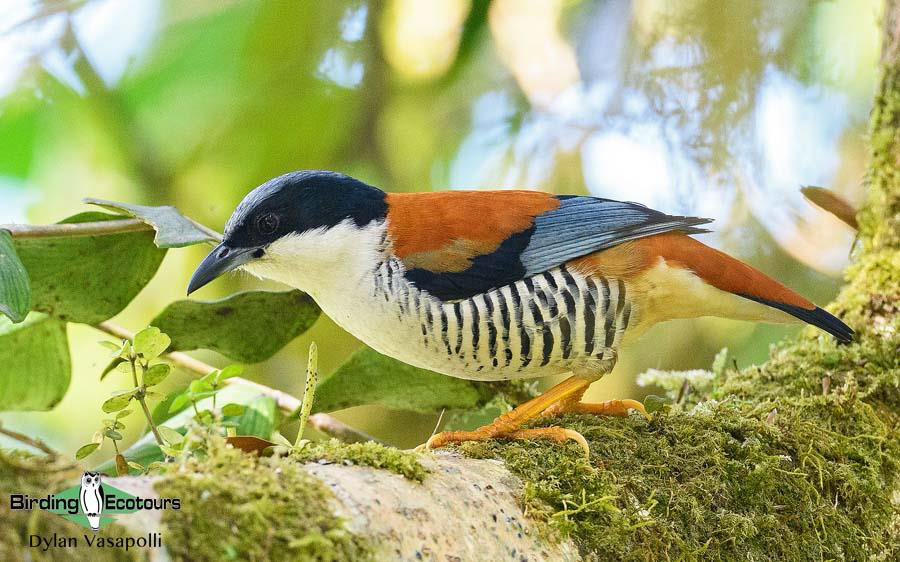
Himalayan Cutia, a beautiful and charismatic species
The afternoon birding back near Lama Camp afforded prolonged close-up views of a Rufous-throated Wren-Babbler, beautiful Golden-breasted Fulvettas and many other species we’d seen previously. We continued to enjoy exciting, fast-moving mixed-species flocks.
In the evening, we heard Grey Nightjar, Hodgson’s Frogmouth and Mountain Scops Owl near Lama Camp, and saw a Bhutan Giant Flying Squirrel.
Day 12, 8th March 2024. Lama Camp to Kaziranga National Park
We left Lama Camp just as it was getting light, and immediately heard a Grey Nightjar which we stopped for and finally got good views of. We then embarked on our long drive down onto the Assamese plains where we would spend two nights at Kaziranga National Park. Shortly after crossing the huge Brahmaputra River, we stopped at Lake Brahmaputra for some great birding. A female Smew, a handful of Ferruginous Ducks and various more common wildfowl such as Indian Spot-billed Duck, Eurasian Wigeon, Eurasian Teal, Ruddy Shelduck and Bar-headed Geese were around. There were stacks of Citrine Wagtails and a couple of White Wagtails around, and we also found Paddyfield, Richard’s and Rosy Pipits. We also saw a couple of Bengal Bush Larks and several Oriental Skylarks and Zitting Cisticolas. Both Bronze-winged and Pheasant-tailed Jacanas and a single Temminck’s Stint were present, while Black-headed Ibises, five heron species and a number of other birds were seen around the lake.
These incredible Greater One-horned (Indian) Rhinoceros were seen in Kaziranga National Park
We got to our comfortable hotel near Kaziranga National Park in time for lunch and an afternoon birding and game drive. This generated 70 bird species and a good number of big mammals. The stars of the show were large numbers of Greater One-horned (Indian) Rhinoceroses (some of them close-up). Also excellent (mammal-wise) were Barasinghas (Swamp Deer), Hog Deers,a couple of Sambars and wild Water Buffalos. Bird-wise, we saw many waterbirds like Spot-billed Pelicans, Bar-headed Geese, Asian Openbills, Asian Woolly-necked Storks and a few Black-necked Storks. There were a few shorebirds around, including Common Greenshanks, Marsh Sandpipers, Common Snipes and some others we had seen earlier in the tour. Grey-headed, Northern and Red-wattled Lapwings were also out in numbers.
Apart from the waterbirds, we saw Eurasian Collared, Red Collared and Spotted Doves, Yellow-footed Green Pigeon, a Green-billed Malkoha, a lot of beautiful Red-breasted Parakeets and smaller numbers of Rose-ringed and Alexandrine Parakeets. Three kingfisher species, including Stork-billed Kingfisher, were good to see, and other splashes of vivid color came in the form of Black-hooded Oriole, Indochinese Roller and several barbet species. A singing Striated Grassbird was also a highlight. Hundreds of Barn Swallows were around and a cute Asian Barred Owlet watched us as we watched it.
Day 13, 9th March 2024. A full day in Kaziranga National Park
We started the day seeing a few good birds around our hotel, including Tickell’s Leaf Warbler, Black-hooded Oriole, Blossom-headed Parakeet, Alexandrine Parakeet, and a male Daurian Redstart amongst others.
We then did a morning game and birding drive into the eastern side of Kaziranga National Park, finding 87 bird species and numerous good mammals. An adorable family of Smooth-coated Otters entertained us for a while, and our first of two Wild Boars showed near the road. We also saw our first Asian Elephants in good numbers, and a Burmese Python right next to the road was a real highlight. Bird-wise, we added several new species to our list. These included a single Lesser Whistling Duck, Greater and Lesser Coucals, Black Storks, a cute Spotted Owlet, Eurasian Hoopoe, Long-tailed Minivet, Brown Shrike, Great Myna and others.
After lunch, we spent the afternoon in the central section of Kaziranga National Park. Here, we obtained good views of Blossom-headed Parakeet, closer views of Slender-billed Vultures than yesterday, Long-tailed Shrike, Spot-winged Starling, Finn’s Weaver and others. A number of Swamp Francolins were seen well in the late afternoon, but we unfortunately just missed a Bengal Tiger nearby. We ended the day back at our hotel with heard-only Blue-naped Pitta.
Day 14, 10th March 2024. Drive back to Guwahati for flight back to Delhi
This was a travel day in preparation for departure from Delhi homewards the following day.
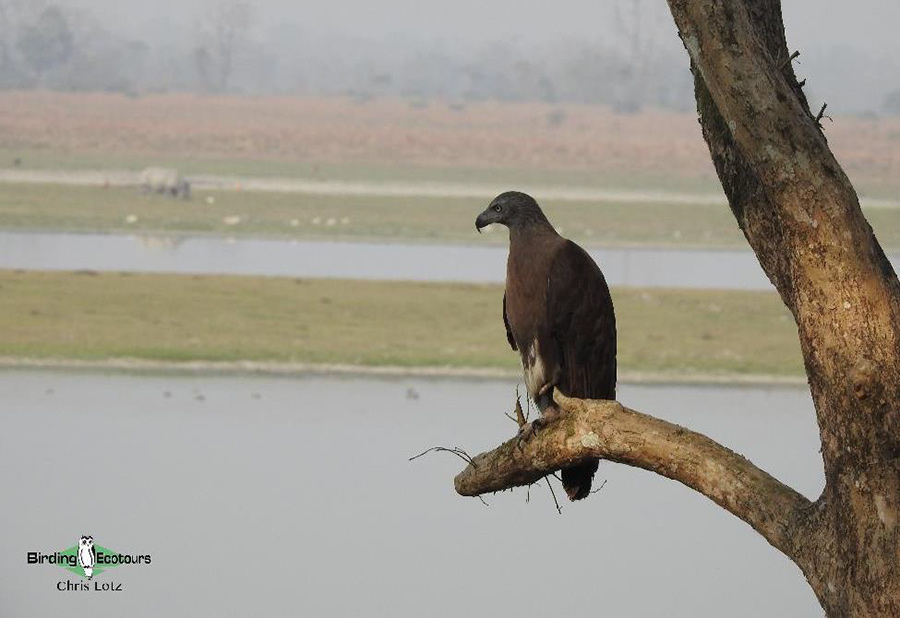
Grey-headed Fish Eagle looking at a rhino
Day 15, 11th March 2024. Delhi
John flew out of Delhi early, on his way to Ghana to go and see more family birds, while Joy and Dave did a city tour of Delhi before their evening flights home.
Bird List – Following IOC (14.1 – December 2023)
Birds ‘heard only’ are marked with (H) after the common name, all other species were seen.
The following notation after species names is used to show conservation status following BirdLife International: CR = Critically Endangered, EN = Endangered, VU = Vulnerable.
| Common name | Scientific name |
| Ducks, Geese, Swans (Anatidae) | |
| Lesser Whistling Duck | Dendrocygna javanica |
| Bar-headed Goose | Anser indicus |
| Common Shelduck | Tadorna tadorna |
| Ruddy Shelduck | Tadorna ferruginea |
| Gadwall | Mareca strepera |
| Eurasian Wigeon | Mareca penelope |
| Indian Spot-billed Duck | Anas poecilorhyncha |
| Northern Pintail | Anas acuta |
| Eurasian Teal | Anas crecca |
| Ferruginous Duck | Aythya nyroca |
| Tufted Duck | Aythya fuligula |
| Smew | Mergellus albellus |
| Common Merganser | Mergus merganser |
| Pheasants & Allies (Phasianidae) | |
| Hill Partridge | Arborophila torqueola |
| Rufous-throated Partridge | Arborophila rufogularis |
| Blood Pheasant | Ithaginis cruentus |
| Blyth’s Tragopan – VU | Tragopan blythii |
| Kalij Pheasant | Lophura leucomelanos |
| Grey Peacock-Pheasant (H) | Polyplectron bicalcaratum |
| Red Junglefowl | Gallus gallus |
| Swamp Francolin – VU | Ortygornis gularis |
| Nightjars (Caprimulgidae) | |
| Grey Nightjar | Caprimulgus jotaka |
| Frogmouths (Podargidae) | |
| Hodgson’s Frogmouth (H) | Batrachostomus hodgsoni |
| Swifts (Apodidae) | |
| Himalayan Swiftlet | Aerodramus brevirostris |
| Asian Palm Swift | Cypsiurus balasiensis |
| Cuckoos (Cuculidae) | |
| Greater Coucal | Centropus sinensis |
| Lesser Coucal | Centropus bengalensis |
| Green-billed Malkoha | Phaenicophaeus tristis |
| Common Hawk-Cuckoo | Hierococcyx varius |
| Large Hawk-Cuckoo | Hierococcyx sparveroides |
| Pigeons, Doves (Columbidae) | |
| Rock Dove | Columba livia |
| Snow Pigeon | Columba leuconota |
| Oriental Turtle Dove | Streptopelia orientalis |
| Eurasian Collared Dove | Streptopelia decaocto |
| Red Collared Dove | Streptopelia tranquebarica |
| Spotted Dove | Spilopelia chinensis |
| Barred Cuckoo-Dove | Macropygia unchall |
| Common Emerald Dove | Chalcophaps indica |
| Yellow-footed Green Pigeon | Treron phoenicopterus |
| Green Imperial Pigeon | Ducula aenea |
| Mountain Imperial Pigeon | Ducula badia |
| Rails, Crakes & Coots (Rallidae) | |
| Eurasian Coot | Fulica atra |
| Black-tailed Crake (H) | Zapornia bicolor |
| White-breasted Waterhen | Amaurornis phoenicurus |
| Grebes (Podicipedidae) | |
| Little Grebe | Tachybaptus ruficollis |
| Stone-curlews, Thick-knees (Burhinidae) | |
| Great Stone-curlew | Esacus recurvirostris |
| Indian Stone-curlew | Burhinus indicus |
| Ibisbill (Ibidorhynchidae) | |
| Ibisbill | Ibidorhyncha struthersii |
| Plovers (Charadriidae) | |
| Little Ringed Plover | Charadrius dubius |
| Long-billed Plover | Charadrius placidus |
| Northern Lapwing | Vanellus vanellus |
| River Lapwing | Vanellus duvaucelii |
| Grey-headed Lapwing | Vanellus cinereus |
| Red-wattled Lapwing | Vanellus indicus |
| Jacanas (Jacanidae) | |
| Pheasant-tailed Jacana | Hydrophasianus chirurgus |
| Bronze-winged Jacana | Metopidius indicus |
| Sandpipers, Snipes (Scolopacidae) | |
| Common Snipe | Gallinago gallinago |
| Common Sandpiper | Actitis hypoleucos |
| Green Sandpiper | Tringa ochropus |
| Marsh Sandpiper | Tringa stagnatilis |
| Common Redshank | Tringa totanus |
| Common Greenshank | Tringa nebularia |
| Temminck’s Stint | Calidris temminckii |
| Coursers, Pratincoles (Glareolidae) | |
| Small Pratincole | Glareola lactea |
| Gulls, Terns, Skimmers (Laridae) | |
| River Tern – VU | Sterna aurantia |
| Storks (Ciconiidae) | |
| Asian Openbill | Anastomus oscitans |
| Lesser Adjutant | Leptoptilos javanicus |
| Greater Adjutant | Leptoptilos dubius |
| Black-necked Stork | Ephippiorhynchus asiaticus |
| Asian Woolly-necked Stork | Ciconia episcopus |
| Black Stork | Ciconia nigra |
| Cormorants, Shags (Phalacrocoracidae) | |
| Little Cormorant | Microcarbo niger |
| Great Cormorant | Phalacrocorax carbo |
| Ibises, Spoonbills (Threskiornithidae) | |
| Black-headed Ibis | Threskiornis melanocephalus |
| Red-naped Ibis | Pseudibis papillosa |
| Glossy Ibis | Plegadis falcinellus |
| Herons, Bitterns (Ardeidae) | |
| Little Egret | Egretta garzetta |
| Indian Pond Heron | Ardeola grayii |
| Eastern Cattle Egret | Bubulcus coromandus |
| Great Egret | Ardea alba |
| Medium Egret | Ardea intermedia |
| Grey Heron | Ardea cinerea |
| Purple Heron | Ardea purpurea |
| Pelicans (Pelecanidae) | |
| Spot-billed Pelican | Pelecanus philippensis |
| Ospreys (Pandionidae) | |
| Osprey | Pandion haliaetus |
| Kites, Hawks, Eagles (Accipitridae) | |
| Black-winged Kite | Elanus caeruleus |
| Bearded Vulture | Gypaetus barbatus |
| Slender-billed Vulture – CR | Gyps tenuirostris |
| Himalayan Vulture | Gyps himalayensis |
| Crested Serpent Eagle | Spilornis cheela |
| Mountain Hawk-Eagle | Nisaetus nipalensis |
| Changeable Hawk-Eagle | Nisaetus cirrhatus |
| Black Eagle | Ictinaetus malaiensis |
| Eastern Imperial Eagle – VU | Aquila heliaca |
| Crested Goshawk | Accipiter trivirgatus |
| Shikra | Accipiter badius |
| Eurasian Sparrowhawk | Accipiter nisus |
| Black Kite | Milvus migrans |
| Pallas’s Fish Eagle – EN | Haliaeetus leucoryphus |
| Grey-headed Fish Eagle | Icthyophaga ichthyaetus |
| Owls (Strigidae) | |
| Brown Boobook | Ninox scutulata |
| Collared Owlet (H) | Taenioptynx brodiei |
| Spotted Owlet | Athene brama |
| Asian Barred Owlet | Glaucidium cuculoides |
| Mountain Scops Owl (H) | Otus spilocephalus |
| Oriental Scops Owl (H) | Otus sunia |
| Collared Scops Owl (H) | Otus lettia |
| Trogons (Trogonidae) | |
| Red-headed Trogon | Harpactes erythrocephalus |
| Hoopoes (Upupidae) | |
| Eurasian Hoopoe | Upupa epops |
| Hornbills (Bucerotidae) | |
| Great Hornbill – VU | Buceros bicornis |
| Indian Grey Hornbill | Ocyceros birostris |
| Rufous-necked Hornbill – VU | Aceros nipalensis |
| Rollers (Coraciidae) | |
| Indochinese Roller | Coracias affinis |
| Kingfishers (Alcedinidae) | |
| Stork-billed Kingfisher | Pelargopsis capensis |
| White-throated Kingfisher | Halcyon smyrnensis |
| Common Kingfisher | Alcedo atthis |
| Pied Kingfisher | Ceryle rudis |
| Bee-eaters (Meropidae) | |
| Asian Green Bee-eater | Merops orientalis |
| Chestnut-headed Bee-eater | Merops leschenaulti |
| Asian Barbets (Megalaimidae) | |
| Great Barbet | Psilopogon virens |
| Brown-headed Barbet | Psilopogon zeylanicus |
| Lineated Barbet | Psilopogon lineatus |
| Golden-throated Barbet | Psilopogon franklinii |
| Blue-throated Barbet | Psilopogon asiaticus |
| Coppersmith Barbet (H) | Psilopogon haemacephalus |
| Honeyguides (Indicatoridae) | |
| Yellow-rumped Honeyguide | Indicator xanthonotus |
| Woodpeckers (Picidae) | |
| Crimson-naped Woodpecker | Dryobates cathpharius |
| Rufous-bellied Woodpecker | Dendrocopos hyperythrus |
| Fulvous-breasted Woodpecker | Dendrocopos macei |
| Darjeeling Woodpecker | Dendrocopos darjellensis |
| Greater Yellownape | Chrysophlegma flavinucha |
| Lesser Yellownape | Picus chlorolophus |
| Black-rumped Flameback | Dinopium benghalense |
| Greater Flameback | Chrysocolaptes guttacristatus |
| Bay Woodpecker | Blythipicus pyrrhotis |
| Caracaras, Falcons (Falconidae) | |
| Common Kestrel | Falco tinnunculus |
| Oriental Hobby | Falco severus |
| Peregrine Falcon | Falco peregrinus |
| Old World Parrots (Psittaculidae) | |
| Blossom-headed Parakeet | Psittacula roseata |
| Red-breasted Parakeet | Psittacula alexandri |
| Alexandrine Parakeet | Psittacula eupatria |
| Rose-ringed Parakeet | Psittacula krameri |
| Pittas (Pittidae) | |
| Blue-naped Pitta (H) | Hydrornis nipalensis |
| Ioras (Aegithinidae) | |
| Common Iora | Aegithina tiphia |
| Cuckooshrikes (Campephagidae) | |
| Grey-chinned Minivet | Pericrocotus solaris |
| Short-billed Minivet | Pericrocotus brevirostris |
| Long-tailed Minivet | Pericrocotus ethologus |
| Scarlet Minivet | Pericrocotus speciosus |
| Black-winged Cuckooshrike | Lalage melaschistos |
| Vireos, Greenlets, Shrike-babblers (Vireonid6ae) | |
| Green Shrike-babbler | Pteruthius xanthochlorus |
| Black-eared Shrike-babbler | Pteruthius melanotis |
| Black-headed Shrike-babbler | Pteruthius rufiventer |
| White-browed Shrike-babbler | Pteruthius aeralatus |
| White-bellied Erpornis | Erpornis zantholeuca |
| Figbirds, Old World Orioles, Piopios (Oriolidae) | |
| Maroon Oriole | Oriolus traillii |
| Black-hooded Oriole | Oriolus xanthornus |
| Drongos (Dicruridae) | |
| Bronzed Drongo | Dicrurus aeneus |
| Lesser Racket-tailed Drongo | Dicrurus remifer |
| Greater Racket-tailed Drongo | Dicrurus paradiseus |
| Hair-crested Drongo | Dicrurus hottentottus |
| Ashy Drongo | Dicrurus leucophaeus |
| Black Drongo | Dicrurus macrocercus |
| Fantails (Rhipiduridae) | |
| White-throated Fantail | Rhipidura albicollis |
| Monarchs (Monarchidae) | |
| Black-naped Monarch | Hypothymis azurea |
| Shrikes (Laniidae) | |
| Brown Shrike | Lanius cristatus |
| Long-tailed Shrike | Lanius schach |
| Grey-backed Shrike | Lanius tephronotus |
| Crows, Jays (Corvidae) | |
| Yellow-billed Blue Magpie | Urocissa flavirostris |
| Rufous Treepie | Dendrocitta vagabunda |
| Spotted Nutcracker | Nucifraga caryocatactes |
| Red-billed Chough | Pyrrhocorax pyrrhocorax |
| House Crow | Corvus splendens |
| Large-billed Crow | Corvus macrorhynchos |
| Fairy Flycatchers (Stenostiridae) | |
| Yellow-bellied Fantail | Chelidorhynx hypoxanthus |
| Grey-headed Canary-flycatcher | Culicicapa ceylonensis |
| Tits, Chickadees (Paridae) | |
| Yellow-browed Tit | Sylviparus modestus |
| Sultan Tit | Melanochlora sultanea |
| Rufous-vented Tit | Periparus rubidiventris |
| Coal Tit | Periparus ater |
| Grey-crested Tit | Lophophanes dichrous |
| Cinereous Tit | Parus cinereus |
| Green-backed Tit | Parus monticolus |
| Yellow-cheeked Tit | Machlolophus spilonotus |
| Larks (Alaudidae) | |
| Bengal Bush Lark | Mirafra assamica |
| Oriental Skylark | Alauda gulgula |
| Sand Lark | Alaudala raytal |
| Bulbuls (Pycnonotidae) | |
| White-throated Bulbul | Alophoixus flaveolus |
| Striated Bulbul | Alcurus striatus |
| Black Bulbul | Hypsipetes leucocephalus |
| Black-crested Bulbul | Rubigula flaviventris |
| Red-whiskered Bulbul | Pycnonotus jocosus |
| Red-vented Bulbul | Pycnonotus cafer |
| Swallows, Martins (Hirundinidae) | |
| Pale Martin | Riparia diluta |
| Barn Swallow | Hirundo rustica |
| Cupwings (Pnoepygidae) | |
| Pygmy Cupwing (H) | Pnoepyga pusilla |
| Scaly-breasted Cupwing | Pnoepyga albiventer |
| Cettia Bush Warblers & Allies (Cettiidae) | |
| Yellow-bellied Warbler | Abroscopus superciliaris |
| Black-faced Warbler | Abroscopus schisticeps |
| Brown-flanked Bush Warbler | Horornis fortipes |
| Aberrant Bush Warbler | Horornis flavolivaceus |
| Slaty-bellied Tesia (H) | Tesia olivea |
| Grey-sided Bush Warbler | Cettia brunnifrons |
| Chestnut-headed Tesia | Cettia castaneocoronata |
| Bushtits (Aegithalidae) | |
| White-browed Tit-warbler | Leptopoecile sophiae |
| Black-throated Bushtit | Aegithalos concinnus |
| Rufous-fronted Bushtit | Aegithalos iouschistos |
| Leaf Warblers (Phylloscopidae) | |
| Buff-barred Warbler | Phylloscopus pulcher |
| Ashy-throated Warbler | Phylloscopus maculipennis |
| Yellow-browed Warbler | Phylloscopus inornatus |
| Lemon-rumped Warbler | Phylloscopus chloronotus |
| Tickell’s Leaf Warbler | Phylloscopus affinis |
| Dusky Warbler | Phylloscopus fuscatus |
| Common Chiffchaff | Phylloscopus collybita |
| Grey-cheeked Warbler | Phylloscopus poliogenys |
| Chestnut-crowned Warbler | Phylloscopus castaniceps |
| Blyth’s Leaf Warbler | Phylloscopus reguloides |
| Grey-hooded Warbler | Phylloscopus xanthoschistos |
| Grassbirds & Allies (Locustellidae) | |
| Striated Grassbird | Megalurus palustris |
| Cisticolas & Allies (Cisticolidae) | |
| Fan-tailed Warbler | Cisticola juncidis |
| Black-throated Prinia | Prinia atrogularis |
| Grey-breasted Prinia | Prinia hodgsonii |
| Common Tailorbird | Orthotomus sutorius |
| Parrotbills & Allies (Paradoxornithidae) | |
| Fire-tailed Myzornis | Myzornis pyrrhoura |
| Golden-breasted Fulvetta | Lioparus chrysotis |
| Brown-throated Fulvetta | Fulvetta ludlowi |
| Manipur Fulvetta | Fulvetta manipurensis |
| Brown Parrotbill | Paradoxornis unicolor |
| White-breasted Parrotbill | Paradoxornis ruficeps |
| White-eyes (Zosteropidae) | |
| Black-chinned Yuhina | Yuhina nigrimenta |
| Whiskered Yuhina | Yuhina flavicollis |
| White-naped Yuhina | Yuhina bakeri |
| Stripe-throated Yuhina | Yuhina gularis |
| Rufous-vented Yuhina | Yuhina occipitalis |
| Indian White-eye | Zosterops palpebrosus |
| Babblers, Scimitar Babblers (Timaliidae) | |
| Pin-striped Tit-Babbler | Mixornis gularis |
| Golden Babbler | Cyanoderma chrysaeum |
| Rufous-capped Babbler | Cyanoderma ruficeps |
| Rufous-throated Wren-Babbler | Spelaeornis caudatus |
| Black-crowned Scimitar Babbler | Pomatorhinus ferruginosus |
| Streak-breasted Scimitar Babbler | Pomatorhinus ruficollis |
| Sikkim Wedge-billed Babbler | Stachyris humei |
| Ground Babblers (Pellorneidae) | |
| Yellow-throated Fulvetta | Schoeniparus cinereus |
| Rufous-winged Fulvetta | Schoeniparus castaneceps |
| Buff-breasted Babbler | Pellorneum tickelli |
| Abbott’s Babbler | Malacocincla abbotti |
| Laughingthrushes & Allies (Leiothrichidae) | |
| Striated Laughingthrush | Grammatoptila striata |
| Himalayan Cutia | Cutia nipalensis |
| Bhutan Laughingthrush | Trochalopteron imbricatum |
| Black-faced Laughingthrush | Trochalopteron affine |
| Chestnut-crowned Laughingthrush | Trochalopteron erythrocephalum |
| Long-tailed Sibia | Heterophasia picaoides |
| Beautiful Sibia | Heterophasia pulchella |
| Hoary-throated Barwing | Actinodura nipalensis |
| Streak-throated Barwing | Actinodura waldeni |
| Blue-winged Minla | Actinodura cyanouroptera |
| Bar-throated Minla | Actinodura strigula |
| Rusty-fronted Barwing | Actinodura egertoni |
| Silver-eared Mesia – EN | Leiothrix argentauris |
| Red-tailed Minla | Minla ignotincta |
| Red-faced Liocichla | Liocichla phoenicea |
| Jungle Babbler | Argya striata |
| White-crested Laughingthrush (H) | Garrulax leucolophus |
| Spotted Laughingthrush | Ianthocincla ocellata |
| White-throated Laughingthrush | Pterorhinus albogularis |
| Grey-sided Laughingthrush | Pterorhinus caerulatus |
| Goldcrests, Kinglets (Regulidae) | |
| Goldcrest | Regulus regulus |
| Elachura (Elachuridae) | |
| Spotted Elachura | Elachura formosa |
| Wrens (Troglodytidae) | |
| Eurasian Wren | Troglodytes troglodytes |
| Nuthatches (Sittidae) | |
| Sitta formosa | |
| White-tailed Nuthatch | Sitta himalayensis |
| Wallcreeper (Tichodromidae) | |
| Wallcreeper | Tichodroma muraria |
| Treecreepers (Certhiidae) | |
| Rusty-flanked Treecreeper | Certhia nipalensis |
| Sikkim Treecreeper | Certhia discolor |
| Starlings, Rhabdornises (Sturnidae) | |
| Spot-winged Starling | Saroglossa spilopterus |
| Great Myna | Acridotheres grandis |
| Jungle Myna | Acridotheres fuscus |
| Bank Myna | Acridotheres ginginianus |
| Common Myna | Acridotheres tristis |
| Indian Pied Myna | Gracupica contra |
| Chestnut-tailed Starling | Sturnia malabarica |
| Thrushes (Turdidae) | |
| Grandala | Grandala coelicolor |
| Green Cochoa (H) | Cochoa viridis |
| Long-tailed Thrush | Zoothera dixoni |
| Grey-winged Blackbird | Turdus boulboul |
| White-collared Blackbird | Turdus albocinctus |
| Chats, Old World Flycatchers (Muscicapidae) | |
| Oriental Magpie-Robin | Copsychus saularis |
| Small Niltava | Niltava macgrigoriae |
| Large Niltava | Niltava grandis |
| Pale-chinned Flycatcher | Cyornis poliogenys |
| Slaty-backed Forktail | Enicurus schistaceus |
| Spotted Forktail | Enicurus maculatus |
| Blue Whistling Thrush | Myophonus caeruleus |
| Pygmy Flycatcher | Ficedula hodgsoni |
| Rufous-gorgeted Flycatcher | Ficedula strophiata |
| Little Pied Flycatcher | Ficedula westermanni |
| Taiga Flycatcher | Ficedula albicilla |
| White-browed Bush Robin | Tarsiger indicus |
| Himalayan Bluetail | Tarsiger rufilatus |
| Blue-fronted Redstart | Phoenicurus frontalis |
| Plumbeous Water Redstart | Phoenicurus fuliginosus |
| White-capped Redstart | Phoenicurus leucocephalus |
| Daurian Redstart | Phoenicurus auroreus |
| Hodgson’s Redstart | Phoenicurus hodgsoni |
| Chestnut-bellied Rock Thrush | Monticola rufiventris |
| Blue Rock Thrush | Monticola solitarius |
| Grey Bush Chat | Saxicola ferreus |
| Siberian Stonechat | Saxicola maurus |
| Dippers (Cinclidae) | |
| Brown Dipper | Cinclus pallasii |
| Leafbirds (Chloropseidae) | |
| Golden-fronted Leafbird | Chloropsis aurifrons |
| Orange-bellied Leafbird | Chloropsis hardwickii |
| Flowerpeckers (Dicaeidae) | |
| Yellow-bellied Flowerpecker | Dicaeum melanozanthum |
| Fire-breasted Flowerpecker | Dicaeum ignipectus |
| Scarlet-backed Flowerpecker | Dicaeum cruentatum |
| Sunbirds (Nectariniidae) | |
| Green-tailed Sunbird | Aethopyga nipalensis |
| Black-throated Sunbird | Aethopyga saturata |
| Crimson Sunbird | Aethopyga siparaja |
| Streaked Spiderhunter | Arachnothera magna |
| Old World Sparrows, Snowfinches (Passeridae) | |
| Russet Sparrow | Passer cinnamomeus |
| Eurasian Tree Sparrow | Passer montanus |
| House Sparrow | Passer domesticus |
| Weavers, Widowbirds (Ploceidae) | |
| Finn’s Weaver – EN | Ploceus megarhynchus |
| Accentors (Prunellidae) | |
| Alpine Accentor | Prunella collaris |
| Rufous-breasted Accentor | Prunella strophiata |
| Wagtails, Pipits (Motacillidae) | |
| Eastern Yellow Wagtail | Motacilla tschutschensis |
| Citrine Wagtail | Motacilla citreola |
| Grey Wagtail | Motacilla cinerea |
| White Wagtail | Motacilla alba |
| White-browed Wagtail | Motacilla maderaspatensis |
| Richard’s Pipit | Anthus richardi |
| Paddyfield Pipit | Anthus rufulus |
| Olive-backed Pipit | Anthus hodgsoni |
| Rosy Pipit | Anthus roseatus |
| Finches, Euphonias (Fringillidae) | |
| Brown Bullfinch | Pyrrhula nipalensis |
| Red-headed Bullfinch | Pyrrhula erythrocephala |
| Grey-headed Bullfinch | Pyrrhula erythaca |
| Golden-naped Finch | Pyrrhoplectes epauletta |
| Dark-breasted Rosefinch | Procarduelis nipalensis |
| Plain Mountain Finch | Leucosticte nemoricola |
| Himalayan White-browed Rosefinch | Carpodacus thura |
| Red-fronted Rosefinch | Carpodacus puniceus |
| Crimson-browed Finch | Carpodacus subhimachalus |
| Yellow-breasted Greenfinch | Chloris spinoides |
| Tibetan Serin | Spinus thibetanus |
| Buntings (Emberizidae) | |
| Little Bunting | Emberiza pusilla |
| Total seen | 333 |
| Total heard only | 9 |
| Total recorded | 342 |
Mammal List – Following Mammalwatching.com (January 2024)
The following notation after species names is used to show conservation status following IUCN: EN = Endangered, VU = Vulnerable.
| Common name | Scientific name |
| Elephants (Elephantidae) | |
| Asian Elephant – EN | Elephas maximus |
| Old World Monkeys (Cercopithecidae) | |
| Rhesus Macaque | Macaca mulatta |
| Arunachal Macaque – EN | Macaca munzala |
| Capped Langur – VU | Trachypithecus pileatus |
| Squirrels (Sciuridae) | |
| Irrawaddy Squirrel | Callosciurus pygerythrus |
| Himalayan Striped Squirrel | Tamiops mcclellandii |
| Indian Palm Squirrel | Funambulus palmarum |
| Black Giant Squirrel | Ratufa bicolor |
| Bhutan Giant Flying Squirrel | Petaurista nobilis |
| Mustelids (Mustelidae) | |
| Yellow-throated Marten | Martes flavigula |
| Smooth-coated Otter – VU | Lutra perspicillata |
| Felids (Felidae) | |
| Marbled Cat | Pardofelis marmorata |
| Mongooses (Herpestidae) | |
| Small Indian Mongoose | Urva auropunctata |
| Rhinoceroses (Rhinocerotidae) | |
| Greater One-horned Rhinoceros – VU | Rhinoceros unicornis |
| Bovids (Bovidae) | |
| Domestic Yak – DO | Bos grunniens |
| Asian Wild Buffalo – EN | Bubalus arnee |
| Deer (Cervidae) | |
| Hog Deer – EN | Axis porcinus |
| Barasingha – VU | Rucervus duvaucelii |
| Sambar – VU | Rusa unicolor |
| Northern Red Muntjac | Muntiacus vaginalis |
| Suids (Suidae) | |
| Eurasian Wild Pig | Sus scrofa |
| Total seen | 21 |
Reptile List – Following The Reptile Database and iNaturalist
| Common name | Scientific name |
| Pythons (Pythonidae) | |
| Burmese Python – VU | Python bivittatus |
| Total seen | 1 |
DOWNLOAD TRIP REPORT
This is a sample trip report. Please email us ([email protected]) for more trip reports from this destination.
